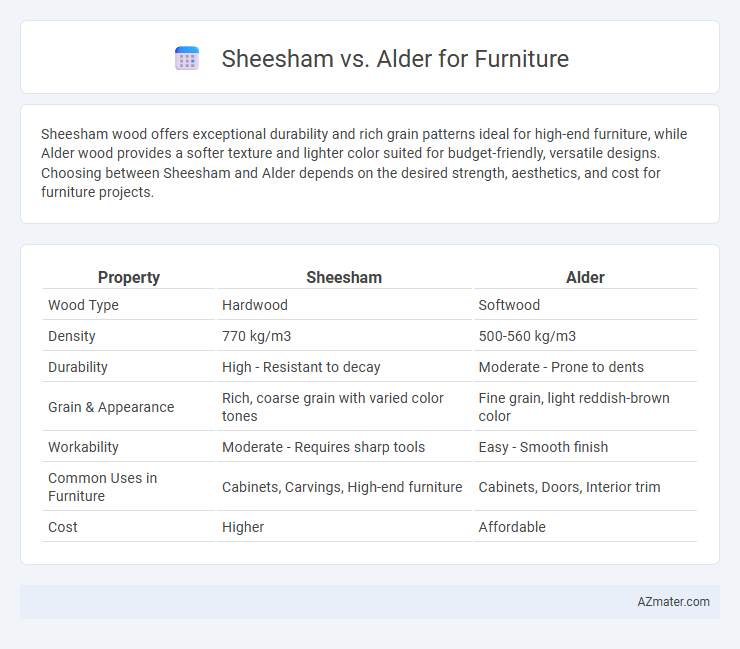Sheesham wood offers exceptional durability and rich grain patterns ideal for high-end furniture, while Alder wood provides a softer texture and lighter color suited for budget-friendly, versatile designs. Choosing between Sheesham and Alder depends on the desired strength, aesthetics, and cost for furniture projects.
Table of Comparison
| Property | Sheesham | Alder |
|---|---|---|
| Wood Type | Hardwood | Softwood |
| Density | 770 kg/m3 | 500-560 kg/m3 |
| Durability | High - Resistant to decay | Moderate - Prone to dents |
| Grain & Appearance | Rich, coarse grain with varied color tones | Fine grain, light reddish-brown color |
| Workability | Moderate - Requires sharp tools | Easy - Smooth finish |
| Common Uses in Furniture | Cabinets, Carvings, High-end furniture | Cabinets, Doors, Interior trim |
| Cost | Higher | Affordable |
Introduction to Sheesham and Alder Woods
Sheesham wood, also known as Indian rosewood, is prized for its rich, dark grain and exceptional durability, making it a popular choice for high-quality furniture. Alder wood offers a lighter, more uniform color with a fine, straight grain, lending a smooth finish ideal for contemporary furniture designs. Both woods provide strong structural integrity but differ significantly in aesthetics and aging properties.
Physical Characteristics Comparison
Sheesham wood features a dense, coarse grain with rich, dark brown hues and natural golden streaks, offering high durability and resistance to wear, making it ideal for heavy-use furniture. Alder wood displays a finer, straight grain with lighter, reddish-brown tones, known for its softness and ease of workmanship but lower hardness compared to Sheesham. The comparative density of Sheesham (approximately 800 kg/m3) exceeds Alder's (around 560 kg/m3), resulting in greater strength and longevity for Sheesham furniture pieces.
Durability and Hardness
Sheesham wood, also known as Indian Rosewood, offers superior durability and hardness compared to Alder, making it ideal for heavy-use furniture that requires long-lasting strength and resistance to wear. Sheesham's Janka hardness rating ranges from 1,260 to 1,410, significantly higher than Alder's 590, resulting in better resistance to dents and scratches. This dense hardwood also boasts excellent natural oils that enhance its durability, whereas Alder, a softer hardwood, is more prone to dents and surface damage over time.
Aesthetic Appeal and Grain Patterns
Sheesham wood features rich, dark hues with intricate grain patterns that provide a luxurious and exotic aesthetic, making it a popular choice for high-end furniture. Alder wood offers a lighter, more uniform color with subtle grain patterns that create a warm and rustic appeal, ideal for casual or contemporary furniture styles. The distinctive swirling grains of Sheesham contrast with the smooth, straight grains of Alder, influencing the design focus and overall visual impact of the furniture.
Workability and Ease of Crafting
Sheesham wood offers superior workability due to its natural oils, which enhance durability and resist cracking during crafting, making it ideal for intricate furniture designs. Alder wood is softer and easier to carve, allowing for smoother cuts and detailed finishes but may lack the long-term strength of Sheesham. Craftsmen often prefer Sheesham for robust, high-end furniture, while Alder suits projects requiring quick shaping and gentle sanding.
Cost and Availability
Sheesham wood is generally more expensive than alder due to its durability and rich grain patterns, making it a premium choice for high-quality furniture. Alder is widely available and more affordable, often used for budget-friendly furniture without sacrificing strength. The availability of Sheesham can be limited depending on the region, whereas alder is commonly sourced and easier to find worldwide.
Environmental Impact and Sustainability
Sheesham wood, sourced from the Dalbergia species, is praised for its natural durability and can be sustainably harvested if managed through certified plantations, reducing deforestation risks. Alder, a fast-growing hardwood native to North America and Europe, offers a more renewable option due to its shorter growth cycle, lower carbon footprint, and ability to sequester carbon efficiently during cultivation. Both woods present eco-friendly choices when sourced responsibly, but alder's rapid renewability and lower environmental impact make it a preferable option for sustainable furniture production.
Maintenance and Longevity
Sheesham wood offers superior durability and requires minimal maintenance compared to Alder, thanks to its natural oil content that resists moisture and pests. Alder wood, while easier to work with and less expensive, demands regular sealing or varnishing to protect against wear and environmental damage. For long-term furniture investment, Sheesham provides greater longevity with less frequent upkeep, making it ideal for heirloom-quality pieces.
Ideal Furniture Applications
Sheesham wood, known for its rich grain and durability, is ideal for high-end furniture pieces like cabinets, dining tables, and ornamental chairs that require strength and aesthetic appeal. Alder wood offers a softer texture and lighter hue, making it perfect for indoor furniture such as bedroom sets, lightweight chairs, and decorative shelving where a smooth finish and ease of molding are prioritized. Choosing Sheesham enhances longevity and intricate designs, while Alder suits budget-friendly, casual furniture with a warm tone.
Final Verdict: Sheesham vs Alder
Sheesham furniture offers exceptional durability and rich, natural grain patterns, making it ideal for long-lasting, visually striking pieces. Alder wood, known for its smooth finish and affordability, provides a lighter tone with excellent workability but may lack Sheesham's strength and resistance to wear. The final verdict favors Sheesham for premium, enduring furniture, while Alder suits budget-friendly, lightweight designs.

Infographic: Sheesham vs Alder for Furniture
 azmater.com
azmater.com